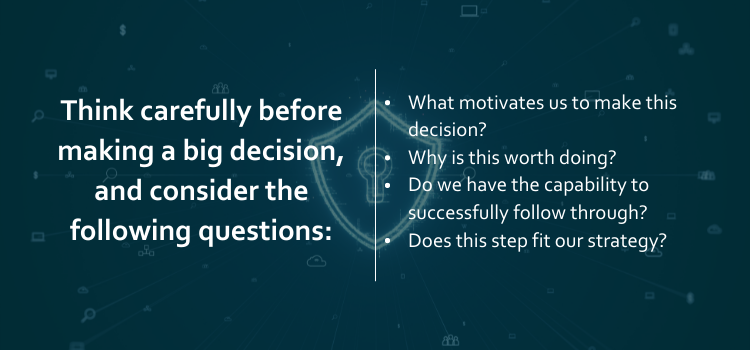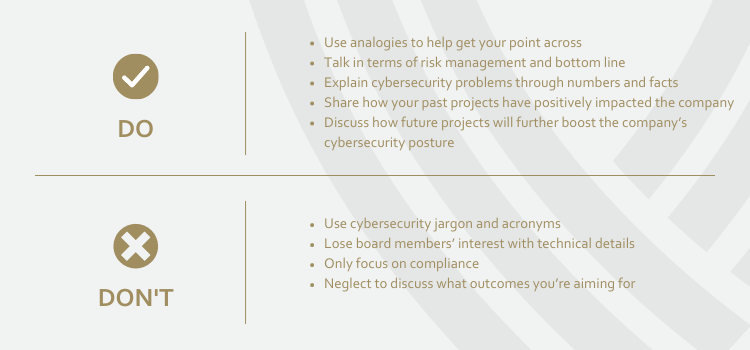
As a CISO, your role is critical in today’s cybersecurity landscape. Managing cybersecurity has become a top priority for organizations worldwide. While your main responsibilities will vary depending on your company’s size and industry, you’re ultimately responsible for taking the lead on cybersecurity efforts. By establishing and maintaining your organization’s cybersecurity strategy, you’re safeguarding critical assets and sensitive data.
The CISO’s role is more complex today than it was even a decade ago. While in the past, CISOs were primarily viewed as technical experts, their role has grown to increasingly focus on business strategy. They no longer work in their own silos but collaborate across departments and regularly communicate with the board.
So, how can CISOs manage all their responsibilities and ensure they keep their seat at the table? We’ve summarized the necessary steps you need to take to develop and implement a strong cybersecurity program.
Effective CISOs adapt to the changing cybersecurity landscape. This guide will outline key strategies to better manage your cybersecurity program and help you develop the right skills to succeed in your role.
Assess Where Your Company Stands
To improve cybersecurity management, you first need to assess the current state of your company’s cybersecurity program.
- Where’s the risk?
- What’s working?
- What needs improvement?
- What areas do you expect to be the most challenging?
A well-oiled cybersecurity program is based on regular risk, threat, and vulnerability assessments. Equally critical is understanding the company’s data and assets. These inputs contribute to understanding what data is critical, who or what can threaten that data, and what’s currently being done to protect it. It helps to look at your data from an intruder’s perspective to understand how they can exploit your vulnerabilities.
Develop A Strategic Cybersecurity Plan
As CISO, it’s your primary responsibility to build and oversee your company’s cybersecurity strategic plan. A comprehensive plan will drive your company’s cybersecurity program and help management make better-informed decisions. It’ll also help management prioritize critical tasks, direct spending, and better manage risks.
The planning process is complex—it will take time to flesh out activities, technology requirements, and budgets. You’ll need to meet with key senior executives to ensure you have a strong handle on your company’s goals, as your plan must align with your company’s short and long-term objectives. A sound overarching strategy coupled with iteratively developed plans based on risk assessment output is an effective approach to building and sustaining cybersecurity plans and programs.
Executive management and board members need to understand the purpose of the plan and visualize how the company will benefit. This is key to success. Thus, the plan should be communicated in simple and clear business language.
Put Your Plan Into Action
Your strategic plan—made up of objectives, strategies, and activities—will inform your company’s direction relating to cybersecurity.
Implementing priority controls and reducing risk through scope reduction-type activities can show quick progress and help increase confidence in your program. In some cases, simple steps such as cleaning up access to sensitive data and tightening up core security processes, such as patch management and device hardening, can provide immediate benefits at a low cost.
An often-overlooked component of a solid cybersecurity strategy is employee awareness. Empowering your first line of defence is another critical and cost-effective step in reducing cybersecurity-related risk.
Monitor and Measure Results
To be successful, your cybersecurity plan must be monitored and measurable. Develop a monitoring and reporting framework to track the progress of your program, projects, and state of controls once implemented. Highlight company successes and identify areas of improvement. Your cybersecurity program should be fluid— adjust your strategy and pivot based on tools put in place to monitor and measure organizational risk. Governance, risk, and compliance methodologies and supporting technologies can be used to provide holistic visibility.
Regularly meet with key stakeholders to get their input on the progress you’ve made, any challenges, and changes to the organization’s risk posture. Leverage the implemented monitoring and reporting framework to help drive effective communication.

Strategies to Improve Cybersecurity Management
- Don’t Just Follow Industry Trends: You definitely want to keep pace with industry trends to continually update your cybersecurity knowledge. Board members will also expect you to be knowledgeable about recent industry-specific data breaches and cybersecurity intelligence reports. When making strategic decisions, however, don’t allow yourself to be distracted by trends; there are no silver bullets. Stick to the plan, using a combination of processes, right-fit technology, and staff training and awareness to increasingly address the highest areas of risk. Possessing deep business knowledge is also key to making smart decisions and thriving in a strategic leadership role.
- Stop Putting out Fires and establish proactive cybersecurity measures: While quickly reacting to cybersecurity incidents is undoubtedly a good thing, your company will fall behind if you only take a reactive approach to cybersecurity. Your cybersecurity personnel will become overwhelmed and overworked if you’re constantly putting out fires. It makes a lot more sense to focus on eliminating risks before they become problems. A purely defensive cybersecurity strategy is really no strategy at all. By being proactive, you’ll better utilize your resources and remain prepared for potential incidents.
- Be Holistic about Cybersecurity: What exactly does it mean to be holistic in the context of cybersecurity? Your technology, people, and processes shouldn’t operate in silos. Rather, they should function as an integrated system. Piecemeal approaches to cybersecurity can only do so much. You need to work together with key stakeholders to identify vulnerabilities, prioritize them, and plan to collectively secure your organization as a whole. Don’t just focus on slowing down the bad guys—this won’t get you far in the big picture. While you need to prioritize what problems to tackle first, don’t lose sight of the big picture. Leverage assessments and your monitoring and reporting framework to maintain a bird’s-eye view and act on high-risk issues.
- Speak in a Language the Board Understands: This is an especially important point as the CISO’s role has become more consultative and collaborative. CISOs tend to speak in a language that is unintelligible to most board members and CEOs. Fortunately, boards are taking a greater interest in cybersecurity due to the global increase in data breaches. As board members become more aware of cybersecurity risks, they want to make sure the company is doing everything possible to get ahead of them. Board members are ready to hear you, but to have a strong voice, you need to speak in a language they understand. A big part of your role as CISO is communicating to board members where your company stands from a cybersecurity perspective and articulating your defensive posture. Be prepared to explain your overall cybersecurity plan, your organization’s cybersecurity culture, and how employees are being educated. Leverage your monitoring and reporting framework to help drive clear and concise communication. You need to continually prove your worth and the importance of cybersecurity. Many board members come from a financial background and care about the company’s growth, reputation, and bottom line. To get the support you need, translate your priorities into terms board members can easily understand and relate to.

- Determine Where Your Company Stands against Competitors: As cybersecurity becomes a primary concern worldwide, you can market your security and privacy measures as a competitive advantage. Review what competitors are doing about cybersecurity and compare your organization against them. Board members are interested in leveraging new market opportunities to increase business efficiency. When communicating your cybersecurity posture to them, demonstrate where you stand compared to peers and competitors in your industry. Show how you’re maintaining an edge over the competition. Show—don’t tell—how cybersecurity breaches can hurt your bottom line and how a strong cybersecurity program can help.
Skills to Develop
- Risk Management: In the past, CISOs were primarily responsible for managing security assets. Today, their role has shifted from security expert to business strategist. CISOs need a thorough understanding of all organizational risks. To be successful, CISOs must take a risk-based approach to cybersecurity. This involves assessing cyber threats and risks to your organization and recommending ways to protect against them. With new threats constantly changing the risk landscape, developing a risk management program is crucial to protecting your company assets.
- Communication: CISOs need to develop certain soft skills to do their job effectively. It’s one thing to have deep technical skills, but you also need to be able to clearly explain all the cybersecurity concepts you’re responsible for managing. CISOs are translators—you need to translate the problems your company is experiencing in a way that board members will understand. Much of your job involves persuading key stakeholders to support your cybersecurity initiatives. Strong communication skills will enable you t
- Interpersonal: Cybersecurity is a company-wide problem, so you’ll be working with various departments and stakeholders. In different aspects of your role, you’ll need to collaborate with experts in IT, compliance, legal, finance, and all other business units in between. Understanding your company’s business strategy and collaborating with leaders will ensure you keep business goals and IT goals aligned. When developing and implementing changes, you need to have your staff on your side. Your role ultimately involves helping other people do things. You don’t make cybersecurity decisions in a bubble. Rather, you work with business leaders to understand risks and guide the company toward making informed decisions.
- Leadership: To best represent your organization’s cybersecurity position, develop a strong executive presence. You serve as a spokesperson for the company’s cybersecurity program—strong leadership skills will help you deliver presentations and influence board members and senior leadership. Having a clear vision is crucial to being a strong leader. This involves being analytical and being able to foresee threats before they can cause damage. A successful CISO is forward-thinking, understands the company’s goals and employees’ needs, and is a respected and trusted business leader.




